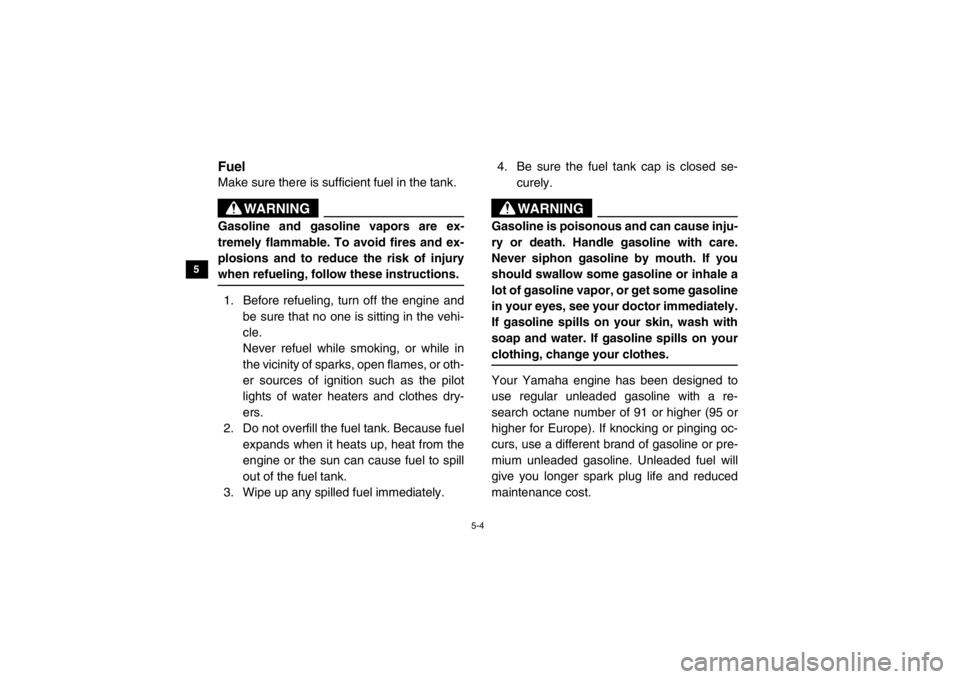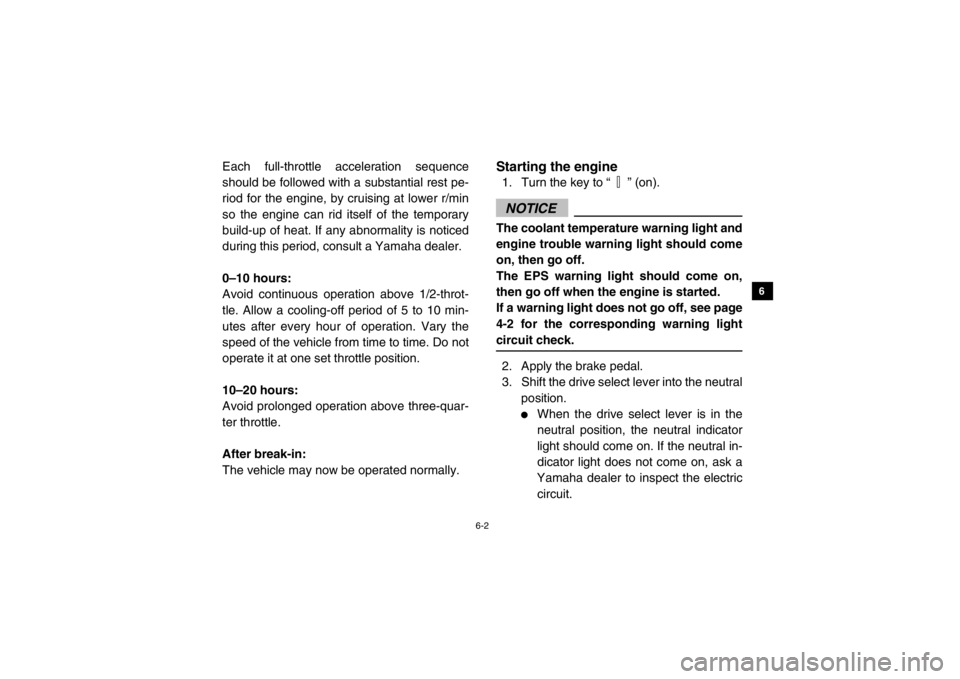Page 62 of 180
4-30
4
5
6
7
8
9
10
11
12
13
14
NOTICE●
Do not use accessories requiring
more than the maximum capacity stat-
ed above. Doing so may overload the
circuit and cause the fuse to blow.
●
If accessories are used without the
engine running, the battery may dis-
charge.
●
Do not use an automotive cigarette
lighter or other accessories with a
plug that gets hot, because the jack
can be damaged.
1XP7B_EE.book Page 30 Tuesday, February 4, 2014 3:40 PM
Page 64 of 180
5-2
5
6
7
8
9
10
11
12
13
14 Final gear oil/
Differential gear oil
Check for leakage. 5-7, 8-15, 8-17
Accelerator pedal Check for proper accelerator pedal operation. 5-7
Seat belts Check for proper operation and belt wear. 5-7
Passenger handhold Check for stability and proper fastening. 5-8, 7-9
Steering Check for proper operation. 5-8
Fittings and fasteners Check all fittings and fasteners. 5-8
Instruments, lights and
switches Check operation, and correct if necessary.
5-8, 8-49, 8-52, 8-53
Wheels and tires Check tire pressure and for wear and damage. 5-8, 8-39, 8-41
Axle boots Check for damage. 8-21
ITEM
ROUTINE PAGE
1XP7B_EE.book Page 2 Tuesday, February 4, 2014 3:40 PM
Page 66 of 180

5-4
5
6
7
8
9
10
11
12
13
14
EVU00400FuelMake sure there is sufficient fuel in the tank.
WARNING
Gasoline and gasoline vapors are ex-
tremely flammable. To avoid fires and ex-
plosions and to reduce the risk of injury
when refueling, follow these instructions.1. Before refueling, turn off the engine and be sure that no one is sitting in the vehi-
cle.
Never refuel while smoking, or while in
the vicinity of sparks, open flames, or oth-
er sources of ignition such as the pilot
lights of water heaters and clothes dry-
ers.
2. Do not overfill the fuel tank. Because fuel
expands when it heats up, heat from the
engine or the sun can cause fuel to spill
out of the fuel tank.
3. Wipe up any spilled fuel immediately. 4. Be sure the fuel tank cap is closed se-
curely.
WARNING
Gasoline is poisonous and can cause inju-
ry or death. Handle gasoline with care.
Never siphon gasoline by mouth. If you
should swallow some gasoline or inhale a
lot of gasoline vapor, or get some gasoline
in your eyes, see your doctor immediately.
If gasoline spills on your skin, wash with
soap and water. If gasoline spills on your
clothing, change your clothes.Your Yamaha engine has been designed to
use regular unleaded gasoline with a re-
search octane number of 91 or higher (95 or
higher for Europe). If knocking or pinging oc-
curs, use a different brand of gasoline or pre-
mium unleaded gasoline. Unleaded fuel will
give you longer spark plug life and reduced
maintenance cost.
1XP7B_EE.book Page 4 Tuesday, February 4, 2014 3:40 PM
Page 70 of 180

5-8
5
6
7
8
9
10
11
12
13
14
A crash can damage the restraint systems in
your vehicle. A damaged restraint system
may not properly protect the person using it,
resulting in serious injury or death in a crash.
To help make sure your restraint systems are
working properly after a crash, have them in-
spected and any necessary replacements
made as soon as possible.Passenger handholdCheck that the handhold bar and its supports
are in good condition. Confirm that the locking
pins are securely fastened, and then push
and pull on the handhold to make sure that it
is not loose.EVU01230SteeringPark on level ground. Turn the steering wheel
right and left. Check for excessive free play,
abnormal noises, or a rough feeling. Have a
Yamaha dealer repair as necessary for proper operation.
EVU00470Fittings and fastenersAlways check the tightness of chassis fittings
and fasteners before a ride. Take the vehicle
to a Yamaha dealer or refer to the Service
Manual for correct tightening torque.Instruments, lights and switchesCheck that all instruments, lights and switches
are working properly. Correct if necessary.Control cablesWhen riding in cold weather, always make
sure all control cables work smoothly before
you begin riding. WARNING! Control cables
can freeze in cold weather and you could
be unable to control the vehicle.EVU00500TiresCheck tire pressure regularly to make sure it
is at the recommended specifications. Also
check for wear and damage.
1XP7B_EE.book Page 8 Tuesday, February 4, 2014 3:40 PM
Page 75 of 180

6-2
1
2
3
4
56
7
8
9
10
11
12
13
14
Each full-throttle acceleration sequence
should be followed with a substantial rest pe-
riod for the engine, by cruising at lower r/min
so the engine can rid itself of the temporary
build-up of heat. If any abnormality is noticed
during this period, consult a Yamaha dealer.
0–10 hours:
Avoid continuous operation above 1/2-throt-
tle. Allow a cooling-off period of 5 to 10 min-
utes after every hour of operation. Vary the
speed of the vehicle from time to time. Do not
operate it at one set throttle position.
10–20 hours:
Avoid prolonged operation above three-quar-
ter throttle.
After break-in:
The vehicle may now be operated normally.
5B410007Starting the engine1. Turn the key to “ ” (on).NOTICEThe coolant temperature warning light and
engine trouble warning light should come
on, then go off.
The EPS warning light should come on,
then go off when the engine is started.
If a warning light does not go off, see page
4-2 for the corresponding warning light
circuit check.2. Apply the brake pedal.
3. Shift the drive select lever into the neutralposition.
●
When the drive select lever is in the
neutral position, the neutral indicator
light should come on. If the neutral in-
dicator light does not come on, ask a
Yamaha dealer to inspect the electric circuit.
1XP7B_EE.book Page 2 Tuesday, February 4, 2014 3:40 PM
Page 78 of 180

6-5
6
7
8
9
10
11
12
13
14
Shifting: neutral to reverse
WARNING
Before you shift into reverse, make sure
there are no obstacles or people behind
you. When it is safe to proceed, go slowly.
Hitting an obstacle or person could result
in serious injury or death.1. Stop the vehicle, take your foot off the ac- celerator pedal, and check behind you.
2. Apply the brake pedal.
3. Shift from neutral to reverse or vice versa
by moving the drive select lever along the
shift guide.
●
When in reverse, the reverse indicator
light should be on. If the light does not
come on, ask a Yamaha dealer to in-
spect the reverse indicator light elec-
trical circuit.
●
Due to the synchronizing mechanism
in the engine, the light may not come
on until the vehicle starts moving.
1. Drive select lever 2. L (Low-range)
3. H (High-range) 4. N (Neutral)
5. R (Reverse)4. Release the parking brake, if applied.
5. Check behind the vehicle for people or obstacles, and then release the brake
pedal.
6. Press the accelerator pedal gradually and continue to watch to the rear while
backing.
1
2
5 4
3
1XP7B_EE.book Page 5 Tuesday, February 4, 2014 3:40 PM
Page 79 of 180
6-6
1
2
3
4
56
7
8
9
10
11
12
13
14
5B410009On-Command drive knobThe vehicle handles differently in each of the drive modes (“2WD”, “4WD” and “DIFF LOCK”). For
example, the vehicle requires more effort to turn in “DIFF LOCK” than in “2WD”. Always stop the
vehicle before changing the position of the On-Command drive knob. The meter display changes
according to the selected drive mode. The different drive indicators, and the differential gear lock
indicator light “DIFF. LOCK” come on as follows:Knob position Indication Drive mode
No indicator light. “2WD” (two-wheel drive): Power is supplied to the rear wheels.
“4WD” (four-wheel drive): Power is supplied to the rear and
front wheels.
“DIFF LOCK” (four-wheel drive with the differential gear
locked): Power is supplied to the rear and front wheels and
the differential gear is locked.
Unlike in four-wheel drive, all wheels turn at the same speed.
1XP7B_EE.book Page 6 Tuesday, February 4, 2014 3:40 PM
Page 80 of 180
6-7
6
7
8
9
10
11
12
13
14
TIP●
When the knob is set to “DIFF LOCK” or “4WD”, the differential gear lock indicator and indi-
cator light will flash until the differential gear is completely locked or unlocked.
●
When the indicator and indicator light are flashing, turning the steering wheel back and forth
will help the differential gear lock to engage or disengage.
●
Riding before the differential gear is properly engaged or disengaged (e.g., when the indica-
tor and indicator light are flashing) will cause the vehicle speed to be limited until the differ-
ential gear is completely engaged or disengaged.
1XP7B_EE.book Page 7 Tuesday, February 4, 2014 3:40 PM